Prevention of Autogenous Shrinkage in High-Strength Mortars with Saturated Tea Waste Particles
Abstract
:1. Introduction
2. Experimental Process
2.1. Materials
2.2. Mix Proportions
2.3. Mixing
2.4. Tests on Fresh and Hardened Mortars
2.4.1. Flow Table Test
2.4.2. Autogenous Shrinkage
2.4.3. Compressive Strength
2.4.4. Flexural Strength
2.4.5. Ultrasonic Pulse Velocity (UPV)
2.4.6. Densities and Absorption Rate of Hardened Mortar Specimens
2.4.7. Scanning Electron Microscopy (SEM)
2.4.8. Thermo-Gravimetric Analysis (TGA)
3. Results and Discussion
3.1. Flow Table Test
3.2. Autogenous Shrinkage
3.3. Compressive Strength
3.4. Flexural Strength
3.5. Ultrasonic Pulse (UP) Velocity
3.6. Densities and Absorption Rate of Hardened Mortar Specimens
3.7. Scanning Electron Microscopy
3.8. Thermo-Gravimetric Analysis
4. Conclusions
- The use of an increasing amount of internal curing agents (black tea waste and perlite) particles with OPC as the only binder, resulted in:
- ○
- Lower flow ability of fresh mortar as compared to the control mix. Tea waste particles reduced flow more as compared to perlite particles. In addition, the coarser particles showed a greater reduction in flow values than finer particles;
- ○
- Reduced autogenous shrinkage as compared to the control mix. A greater reduction in shrinkage was observed in the mixes that contained tea waste particles. Similar to flow values, coarser particles showed more reduction in shrinkage as compared to finer particles;
- ○
- Low compressive and flexural strength values were obtained. Reduction in strength was observed in the specimens that contained tea waste and perlite particles; however, strength gain ratio was found to increase at later ages. The coarser particles showed lower strength values than finer particles;
- ○
- Similar to strength values, low ultrasonic pulse velocity values were obtained. A greater reduction was seen in the specimens that contained tea waste particles as compared to perlite particles;
- ○
- Low density and high absorption rates were obtained in the mixes that contained tea waste and perlite particles as compared to the control mix. The use of silica fume also showed lower density and absorption values as compared to mixes that were made with OPC as the only binder. The lower densities in mixes were attributed to lesser densities of used ingredients; however, the high absorption rates were attributed to the porous structure of used materials;
- ○
- A porous microstructure was seen through SEM analysis in the control mix as compared to mixes that contained tea waste and perlite particles at 28 days. Although the same effect can be seen through the strength analysis, where gain in strength was increasing;
- ○
- More weight loss was found in mixes that contained tea waste particles as compared to the control mix and mixes made with perlite particles. The loss in weight might be due to the evaporation of evaporable water that was inside the pores and the burning of tea waste particles.
- The use of black tea waste and perlite particles with partial addition of silica fume, resulted in:
- ○
- Increased flow and autogenous shrinkage of mortars as compared to specimens without silica fume. High flow ability might be due to round particle shapes of silica fume, and the high shrinkage values might be because of the quick reaction of silica fume particles in presence of water;
- ○
- Increased compressive and flexural strengths and ultrasonic pulse velocity values were obtained as compared to the control mix and other respective mixes. It might be because of the quick reaction of silica fume particles to gain strength at early ages;
- ○
- Densified microstructure and reduced weight loss at age of 28 days. The denser structure in the presence of silica fume was due to filling micro-pores with silica fume particles and the formation of more C-S-H gel in pores of composite, which thus resulted in a reduction in weight loss.
5. Future Work Under Consideration
Author Contributions
Funding
Conflicts of Interest
References
- Ranjbar, N.; Mehrali, M.; Maheri, M.R.; Mehrali, M. Hot-pressed geopolymer. Cem. Concr. Res. 2017, 100, 14–22. [Google Scholar] [CrossRef]
- Schmidt, M.; Fehling, E. Ultra-high-performance concrete: Research, development and application in Europe. ACI Spec. Publ. 2005, 228, 51–78. [Google Scholar]
- Eppers, S.; Müller, C. Autogenous shrinkage strain of ultra-high-performance concrete (UHPC). In Proceedings of the 2nd International Symposium on UHPC, Kassel, Germany, 5–7 March 2008; pp. 433–441. [Google Scholar]
- Huang, H.; Ye, G.; Fehling, E.; Middendorf, B.; Thiemicke, J. Use of rice husk ash for mitigating the autogenous shrinkage of cement pastes at low water cement ratio. In Proceedings of the HiPerMat 2016 4th international symposium on ultra-high performance concrete and high performance construction materials, Kassel, Germany, 9–11 March 2016; pp. 9–11. [Google Scholar]
- Dudziak, L.; Mechtcherine, V. Mitigation of volume changes of ultra-high performance concrete (UHPC) by using super absorbent polymers. In Proceedings of the 2nd International Symposium on Ultra-High Performance Concrete, Kassel, Germany, 5–7 March 2008; Kassel University Press: Kassel, Germany; pp. 425–432. [Google Scholar]
- Aitcin, P.C.; Neville, A.; Acker, P. Integrated view of shrinkage deformation. Concr. Int. 1997, 19, 35–41. [Google Scholar]
- Lura, P.; Jensen, O.M.; Weiss, J. Cracking in cement paste induced by autogenous shrinkage. Mater. Struct. 2009, 42, 1089–1099. [Google Scholar] [CrossRef]
- Bentz, D.P.; Snyder, K.A. Protected paste volume in concrete: Extension to internal curing using saturated lightweight fine aggregate. Cem. Concr. Res. 1999, 29, 1863–1867. [Google Scholar] [CrossRef]
- Boshoff, W.P.; Combrinck, R. Modelling the severity of plastic shrinkage cracking in concrete. Cem. Concr. Res. 2013, 48, 34–39. [Google Scholar] [CrossRef]
- Li, W.; Huang, Z.; Hu, G.; Duan, H.W.; Shah, S.P. Early-age shrinkage development of ultra-high-performance concrete under heat curing treatment. Constr. Build. Mater. 2017, 131, 767–774. [Google Scholar] [CrossRef]
- Jiang, Z.; Sun, Z.; Wang, P. Internal relative humidity distribution in high-performance cement paste due to moisture diffusion and self-desiccation. Cem. Concr. Res. 2006, 36, 320–325. [Google Scholar] [CrossRef]
- Castro, J.; Keiser, L.; Golias, M.; Weiss, J. Absorption and desorption properties of fine lightweight aggregate for application to internally cured concrete mixtures. Cem. Concr. Compos. 2011, 33, 1001–1008. [Google Scholar] [CrossRef]
- Rajabipour, F.; Sant, G.; Weiss, J. Interactions between shrinkage reducing admixtures (SRA) and cement paste’s pore solution. Cem. Concr. Res. 2008, 38, 606–615. [Google Scholar] [CrossRef]
- Sant, G.; Lothenbach, B.; Juilland, P.; Le Saout, G.; Weiss, J.; Scrivener, K. The origin of early age expansions induced in cementitious materials containing shrinkage reducing admixtures. Cem. Concr. Res. 2011, 41, 218–229. [Google Scholar] [CrossRef]
- Bílek, V.; Kalina, L.; Novotný, R.; Tkacz, J.; Pařízek, L. Some issues of shrinkage-reducing admixtures application in alkali-activated slag systems. Materials 2016, 9, 462. [Google Scholar] [CrossRef] [PubMed]
- Jensen, O.M.; Lura, P. Techniques and materials for internal water curing of concrete. Springer Sci. Bus. Media 2006, 39, 817–825. [Google Scholar] [CrossRef]
- Pacheco-Torgal, F.; Melchers, R.; de Belie, N.; Shi, X.; Van Tittelboom, K.; Perez, A.S. (Eds.) Eco-efficient Repair and Rehabilitation of Concrete Infrastructures; Woodhead Publishing: Sawston, UK, 2018; pp. 467–499. [Google Scholar]
- Assmann, A.; Reinhardt, H.W. Tensile creep and shrinkage of SAP modified concrete. Cem. Concr. Res. 2014, 58, 179–185. [Google Scholar] [CrossRef]
- Henkensiefken, R.; Castro, J.; Bentz, D.; Nantung, T.; Weiss, J. Water absorption in internally cured mortar made with water-filled lightweight aggregate. Cem. Concr. Res. 2009, 39, 883–892. [Google Scholar] [CrossRef] [Green Version]
- Kevern, J.T.; Nowasell, Q.C. Internal curing of pervious concrete using lightweight aggregates. Constr. Build. Mater. 2018, 161, 229–235. [Google Scholar] [CrossRef]
- Huang, Z.Y.; Zhang, C.B. Effect of porous superfine powder on the performance of ultra-high performance concrete. Bull. Chin. Ceram. Soc. 2015, 7. [Google Scholar]
- Liu, J.; Shi, C.; Ma, X.; Khayat, K.H.; Zhang, J.; Wang, D. An overview on the effect of internal curing on shrinkage of high performance cement-based materials. Constr. Build. Mater. 2017, 146, 702–712. [Google Scholar] [CrossRef] [Green Version]
- Mignon, A.; Snoeck, D.; Dubruel, P.; Van Vlierberghe, S.; De Belie, N. Crack mitigation in concrete: Superabsorbent polymers as key to success? Materials 2017, 10, 237. [Google Scholar] [CrossRef]
- Urgessa, G.; Choi, K.B.; Yeon, J. Internal relative humidity, autogenous shrinkage, and strength of cement mortar modified with superabsorbent polymers. Polymers 2018, 10, 1074. [Google Scholar] [CrossRef]
- Lura, P.; Wyrzykowski, M.; Tang, C.; Lehmann, E. Internal curing with lightweight aggregate produced from biomass-derived waste. Cem. Concr. Res. 2014, 59, 24–33. [Google Scholar] [CrossRef]
- Jakhrani, S.H.; Kim, H.G.; Jeon, I.K.; Ryou, J.S. Effect of saturated tea waste and perlite particles on early age hydration of high-strength cement mortars. Materials 2019, 12, 2269. [Google Scholar] [CrossRef] [PubMed]
- Saman, N.S.M.; Deraman, R.; Hamzah, M.H. Development of low thermal conductivity brick using rice husk, corn cob and waste tea in clay brick manufacturing. In AIP Conference Proceedings; American Institute of Physics (AIP) Publishing: New York, NY, USA, 2017; Volume 1901, p. 130007. [Google Scholar]
- Kadir, A.A.; Maasom, N. Recycling sugarcane bagasse waste into fired clay brick. Inter. J. Zero Waste Gener. 2013, 1, 21–26. [Google Scholar]
- Görhan, G.; Şimşek, O. Porous clay bricks manufactured with rice husks. Constr. Build. Mater. 2013, 40, 390–396. [Google Scholar] [CrossRef]
- Muñoz, P.; Morales, M.; Mendívil, M.; Juárez, M.; Muñoz, L. Using of waste pomace from winery industry to improve thermal insulation of fired clay bricks. Eco-friendly way of building construction. Constr. Build. Mater. 2014, 71, 181–187. [Google Scholar] [CrossRef]
- Ozturk, S.; Sutcu, M.; Erdogmus, E.; Gencel, O. Influence of tea waste concentration in the physical, mechanical and thermal properties of brick clay mixtures. Constr. Build. Mater. 2019, 217, 592–599. [Google Scholar] [CrossRef]
- Çelik, M.Y.; Celik, F. Turkish tea: The only tea washed with snow that snow falls on. Int. J. Basic. Clin. Stud. 2014, 3, 1–15. [Google Scholar]
- Faostat, Committee on Commodity Problems, Intergovernmental Group on Tea, Twenty-third Session. Available online: http://www.fao.org/3/BU642en/bu642en.pdf (accessed on 21 August 2019).
- ASTM, C. 150/C150M-19a. Standard Specification for Portland Cement; American Society for Testing and Materials, West Conshohocken: Montgomery, PA, USA, 2019.
- ASTM, C. 494/C494M. Standard Specification for Chemical Admixtures for Concrete; American Society for Testing and Materials, West Conshohocken: Montgomery, PA, USA, 2017.
- ASTM, C. 230/C 230M. Standard Specification for Flow Table for Use in Tests of Hydraulic Cement; American Society for Testing and Materials, West Conshohocken: Montgomery, PA, USA, 2004.
- ASTM, C. 1437. Standard Test Method for Flow of Hydraulic Cement Mortar; American Society for Testing and Materials, West Conshohocken: Montgomery, PA, USA, 2001.
- ASTM, C. 1698. Standard Test Method for Autogenous Strain of Cement Paste and Mortar; American Society for Testing and Materials, West Conshohocken: Montgomery, PA, USA, 2009.
- ASTM, C. 109. Standard Test Method For Compressive Strength Of Hydraulic Cement Mortars (Using 2-in of 50-mm Cube Specimens); American Society for Testing and Materials, West Conshohocken: Montgomery, PA, USA, 1998.
- ASTM, C. 348. Standard Test Method for Flexural Strength of Hydraulic-Cement Mortars; American Society for Testing and Materials, West Conshohocken: Montgomery, PA, USA, 2002.
- ASTM, C. 597, Standard Test Method for Pulse Velocity Through Concrete; American Society for Testing and Materials, West Conshohocken: Montgomery, PA, USA, 2009.
- Senff, L.; Modolo, R.C.E.; Ascensão, G.; Hotza, D.; Ferreira, V.M.; Labrincha, J.A. Development of mortars containing superabsorbent polymer. Constr. Build. Mater. 2015, 95, 575–584. [Google Scholar] [CrossRef]
- Justs, J.; Wyrzykowski, M.; Bajare, D.; Lura, P. Internal curing by superabsorbent polymers in ultra-high performance concrete. Cem. Concr. Res. 2015, 76, 82–90. [Google Scholar] [CrossRef]
- Zou, D.; Li, K.; Li, W.; Li, H.; Cao, T. Effects of pore structure and water absorption on internal curing efficiency of porous aggregates. Constr. Build. Mater. 2018, 163, 949–959. [Google Scholar] [CrossRef]
- Wang, X.; Yu, R.; Shui, Z.; Song, Q.; Zhang, Z. Mix design and characteristics evaluation of an eco-friendly Ultra-High Performance Concrete incorporating recycled coral based materials. J. Clean. Product. 2017, 165, 70–80. [Google Scholar] [CrossRef]
- Liu, F.; Wang, J.; Qian, X.; Hollingsworth, J. Internal curing of high performance concrete using cenospheres. Cem. Concr. Res. 2017, 95, 39–46. [Google Scholar] [CrossRef] [Green Version]
- Kumarappa, B.D.; Peethamparan, S.; Ngami, M. Autogenous shrinkage of alkali activated slag mortars: Basic mechanisms and mitigation methods. Cem. Concr. Res. 2018, 109, 1–9. [Google Scholar] [CrossRef]
- Oh, S.; Choi, Y.C. Superabsorbent polymers as internal curing agents in alkali activated slag mortars. Constr. Build. Mater. 2018, 159, 1–8. [Google Scholar] [CrossRef]
- Sakulich, A.R.; Bentz, D.P. Mitigation of autogenous shrinkage in alkali activated slag mortars by internal curing. Mater. Struct. 2013, 46, 1355–1367. [Google Scholar] [CrossRef]
- Dybeł, P.; Furtak, K. Influence of silica fume content on the quality of bond conditions in high-performance concrete specimens. Arch. Civ. Mech. Eng. 2017, 17, 795–805. [Google Scholar] [CrossRef]
- Kim, J.H.; Qudoos, A.; Jakhrani, S.H.; Lee, J.B.; Kim, S.S.; Ryou, J.S. Mechanical properties and sulfate resistance of high volume fly ash cement mortars with air-cooled slag as fine aggregate and polypropylene fibers. Materials 2019, 12, 469. [Google Scholar] [CrossRef]
- Ahmed, S.I.; Shaikh, F.A.; Jakhrani, S.H.; Mushtaq, M.Y.; Sidiqy, J.A. Mechanical behavior of normal concrete reinforced with kantharo suter fiber. Civ. Eng. J. 2017, 3, 487–495. [Google Scholar]
- Huang, Y.; Xu, C.; Li, H.; Jiang, Z.; Gong, Z.; Yang, X.; Chen, Q. Utilization of the black tea powder as multifunctional admixture for the hemihydrate gypsum. J. Clean. Product. 2019, 210, 231–237. [Google Scholar] [CrossRef]
- Jiang, S.; Zhou, D.; Zhang, L.; Ouyang, J.; Yu, X.; Cui, X.; Han, B. Comparison of compressive strength and electrical resistivity of cementitious composites with different nano-and micro-fillers. Arch. Civ. Mech. Eng. 2018, 18, 60–68. [Google Scholar] [CrossRef]
- Rahul, A.; Santhanam, M.; Meena, H.; Ghani, Z. 3D printable concrete: Mixture design and test methods. Cem. Concr. Compos. 2019, 97, 13–23. [Google Scholar] [CrossRef]
- Amran, Y.M.; Farzadnia, N.; Ali, A.A. Properties and applications of foamed concrete:A review. Constr. Build. Mater. 2015, 101, 990–1005. [Google Scholar] [CrossRef]
- Qudoos, A.; Kim, H.G.; Ryou, J.S. Influence of the surface roughness of crushed natural aggregates on the microhardness of the interfacial transition zone of concrete with mineral admixtures and polymer latex. Constr. Build. Mater. 2018, 168, 946–957. [Google Scholar] [CrossRef]
- Kong, D.L.; Sanjayan, J.G. Effect of elevated temperatures on geopolymer paste, mortar and concrete. Cem. Concr. Res. 2010, 40, 334–339. [Google Scholar] [CrossRef]
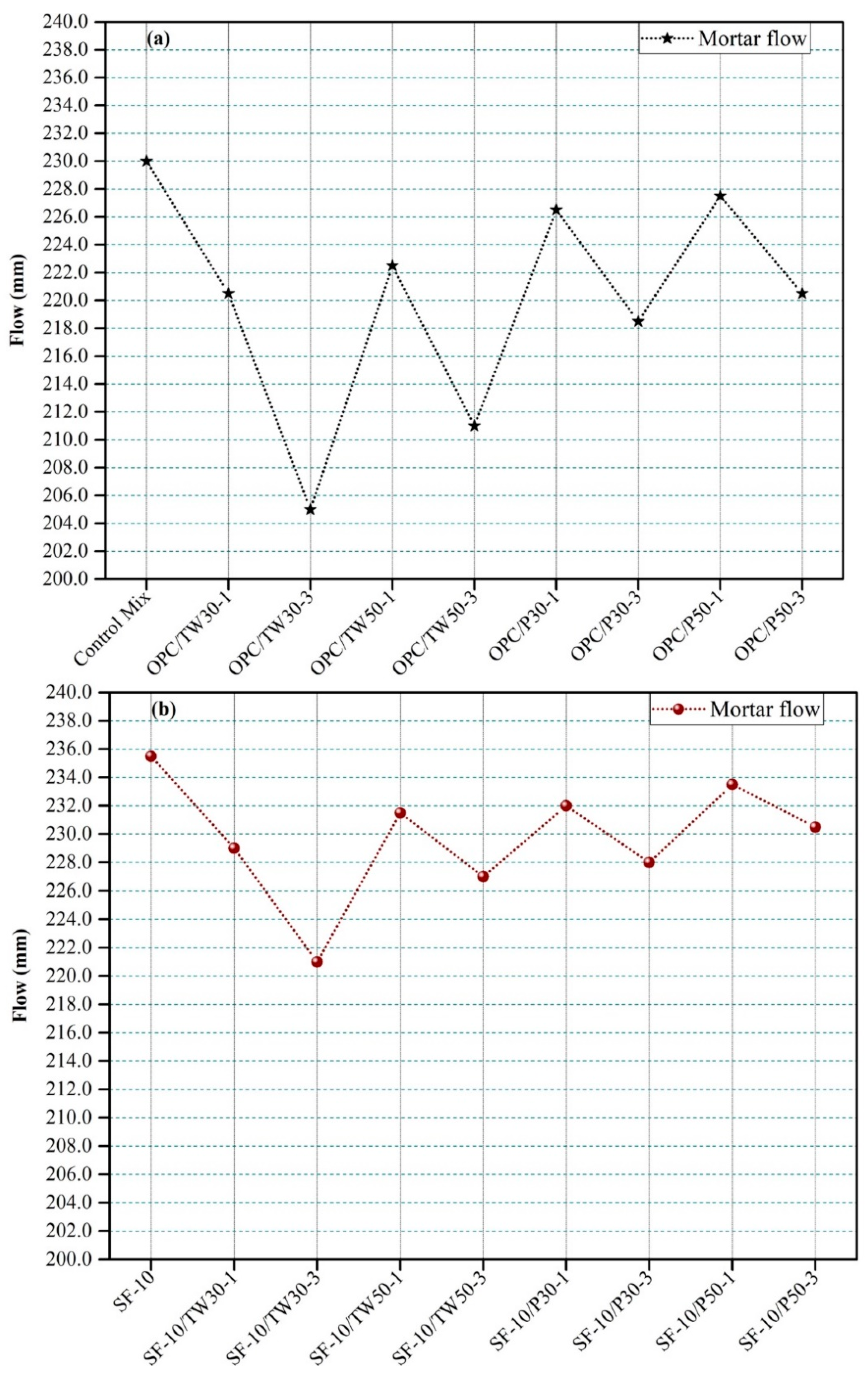
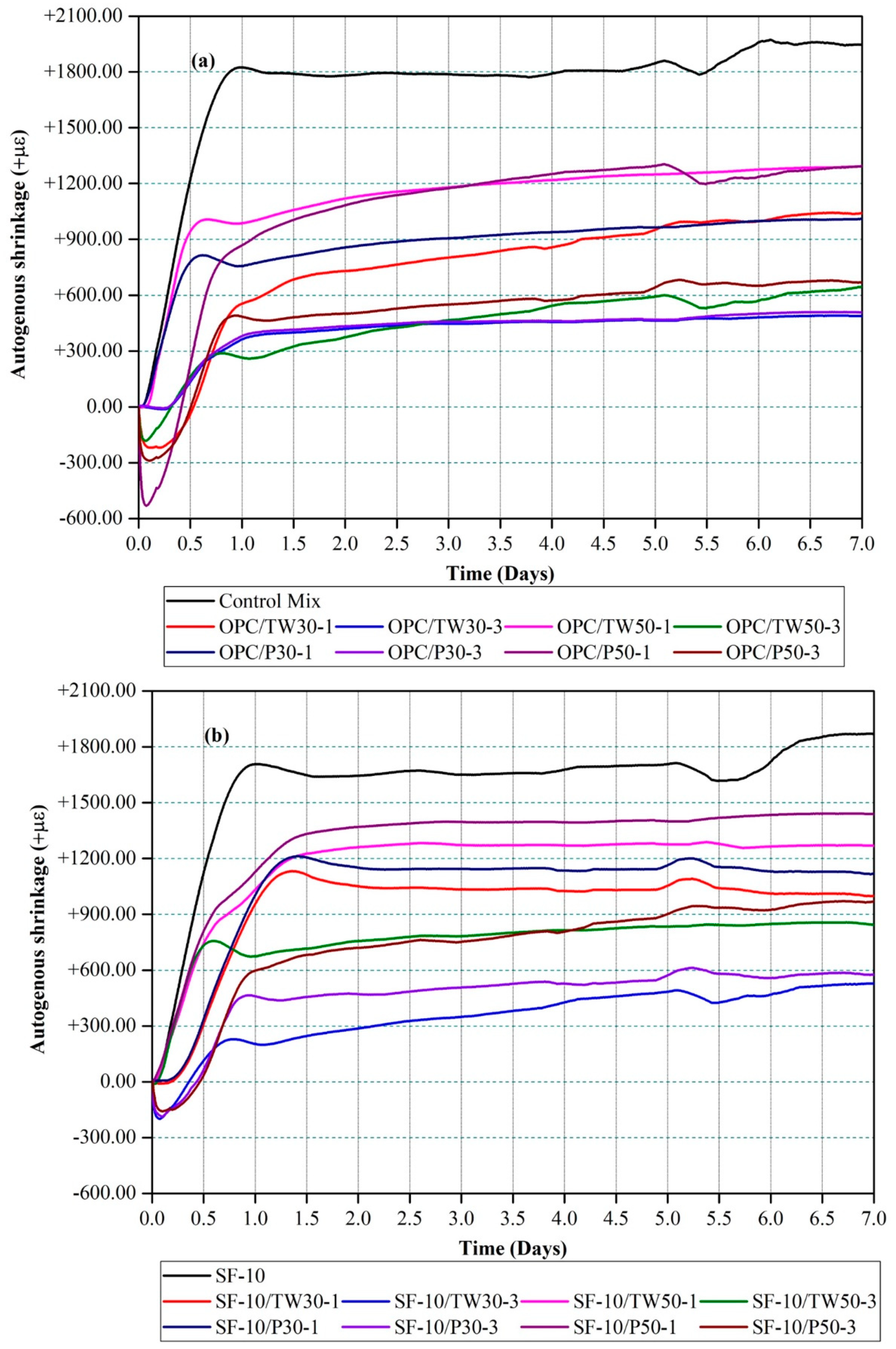
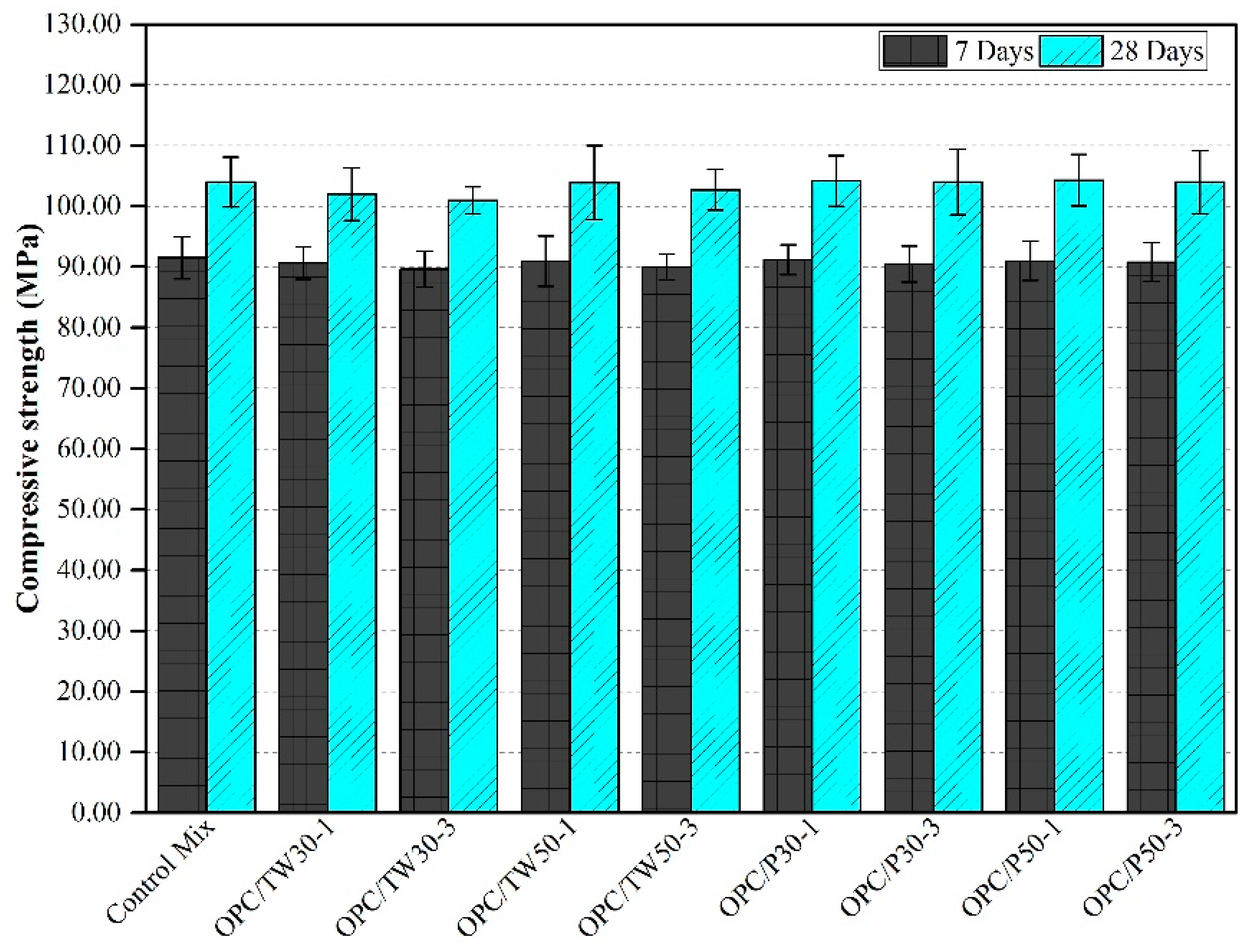
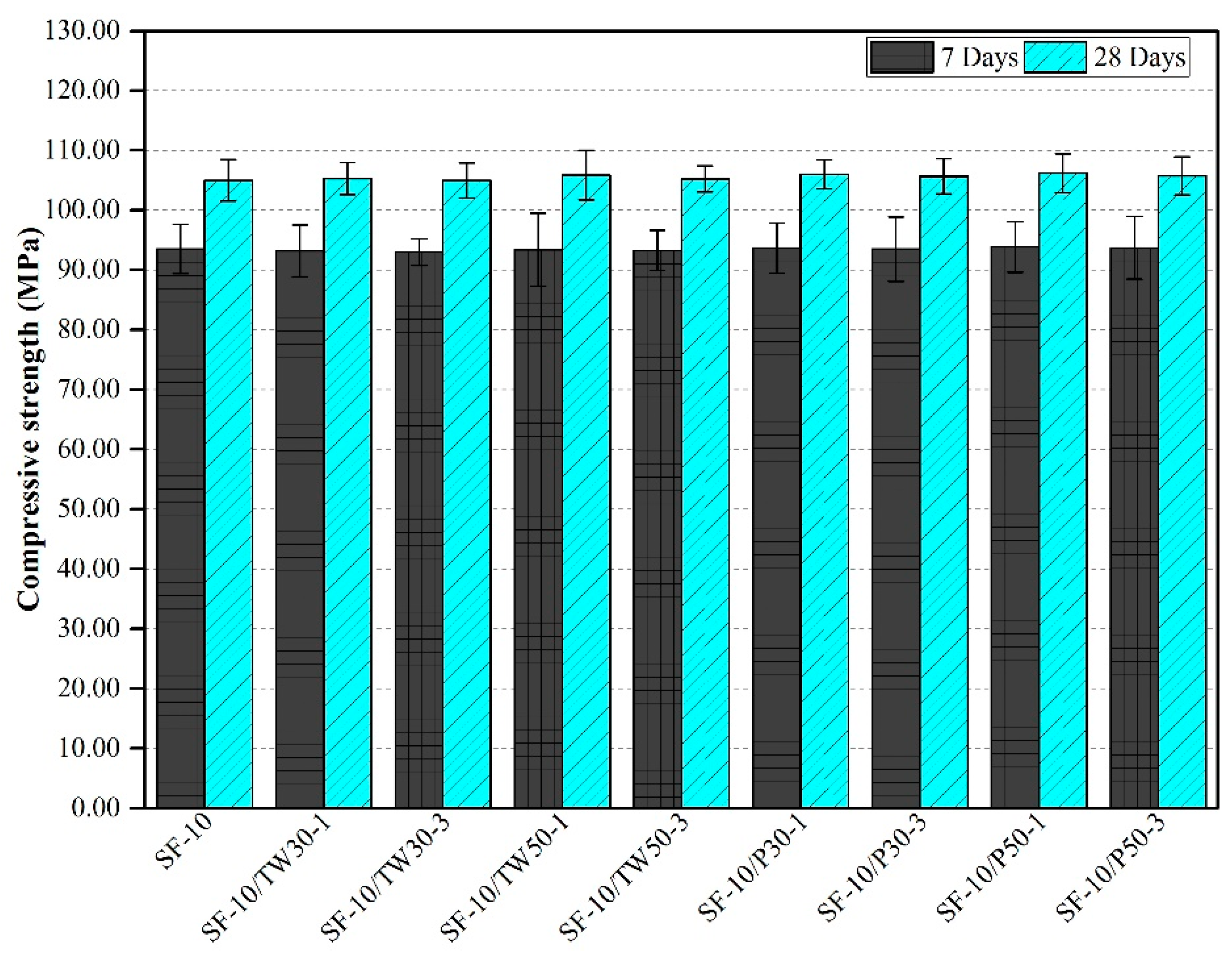
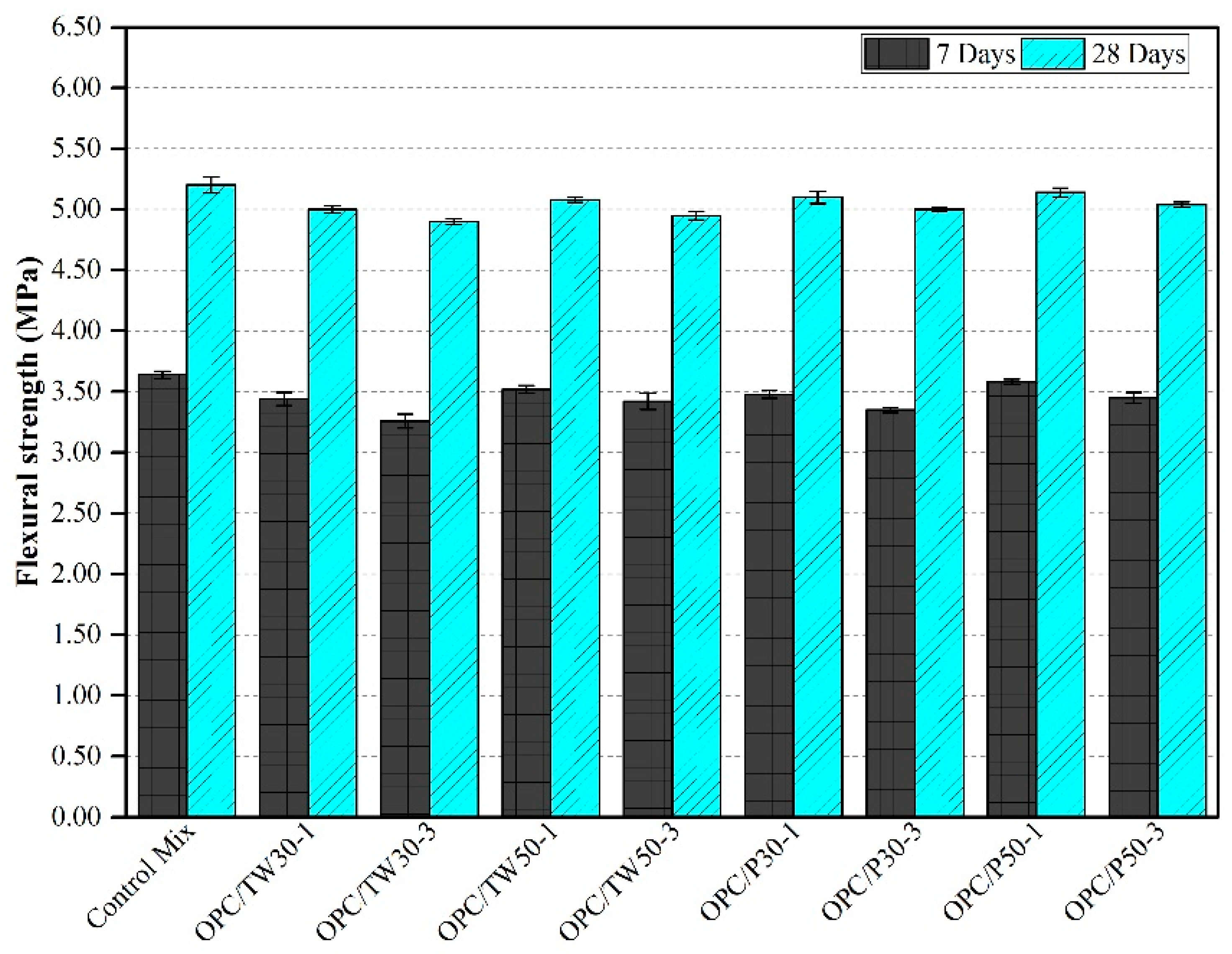

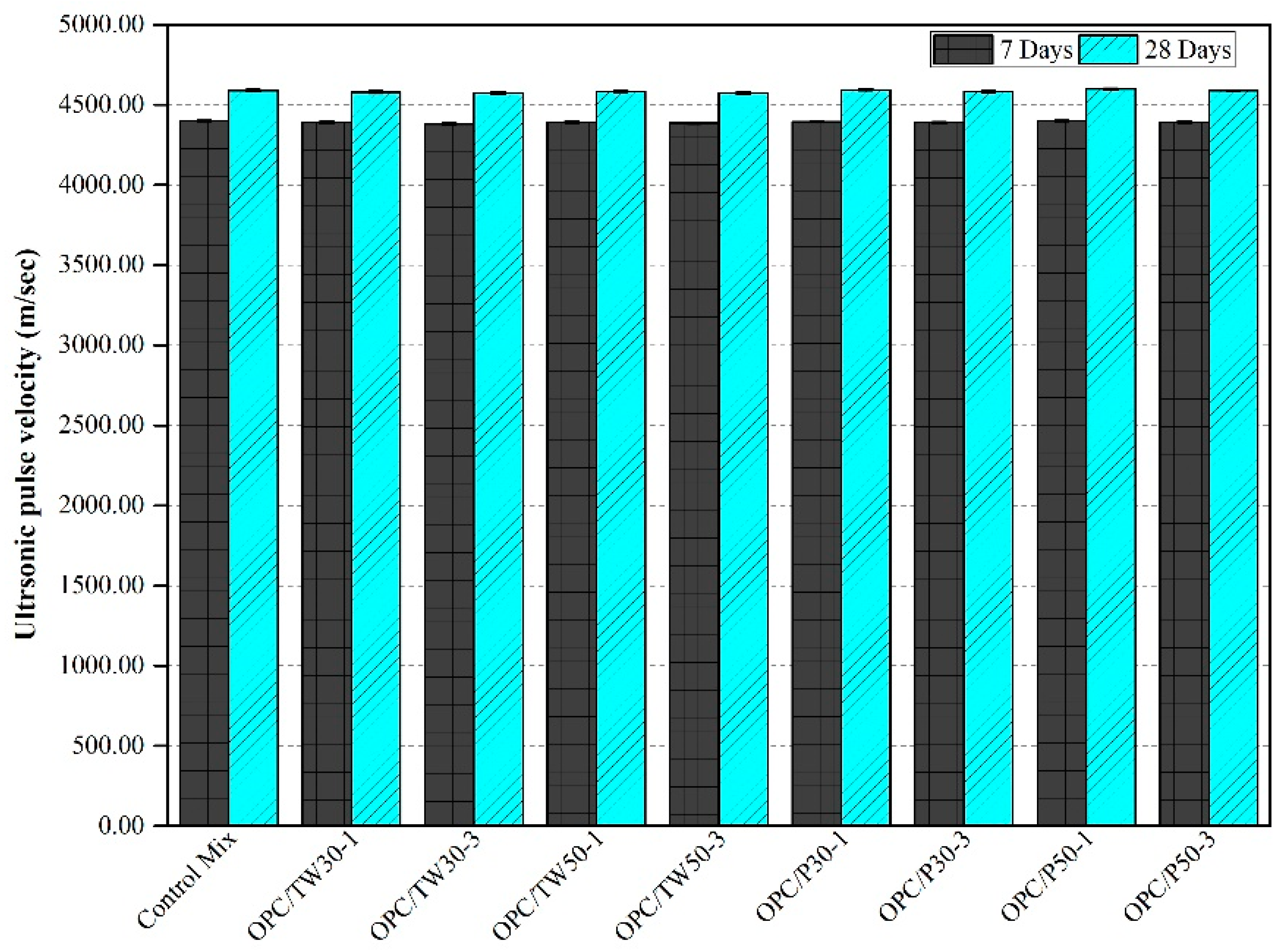

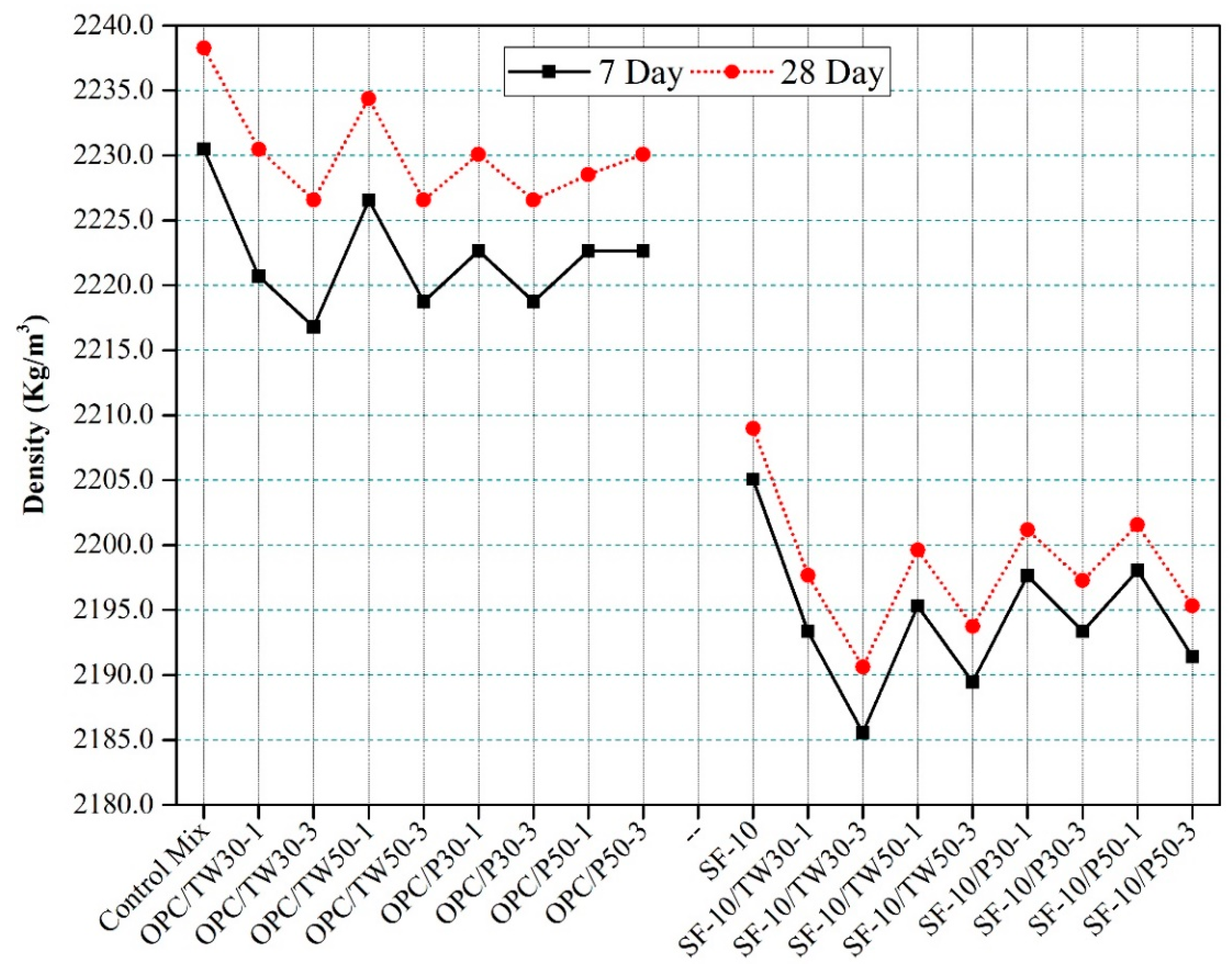

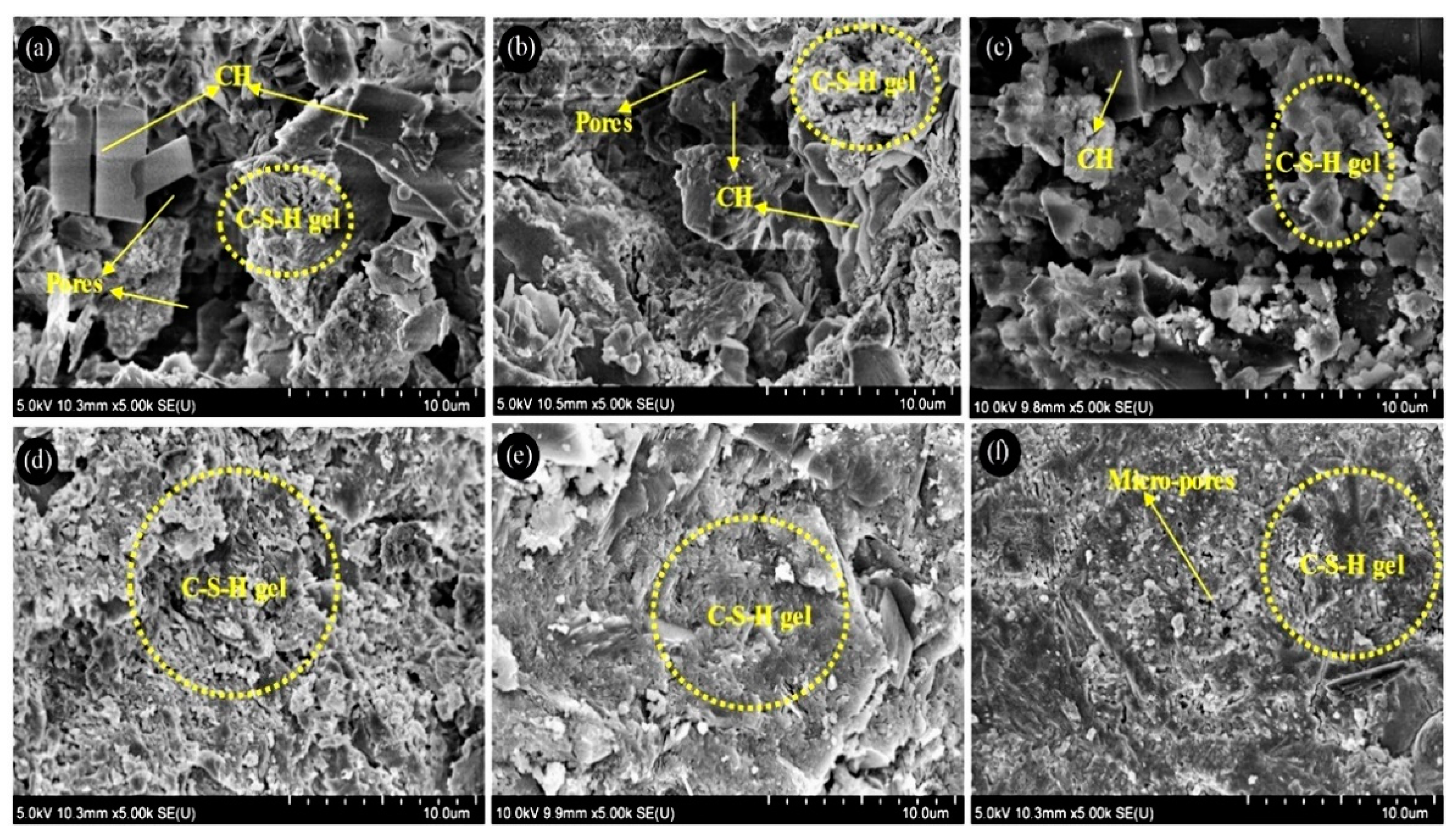
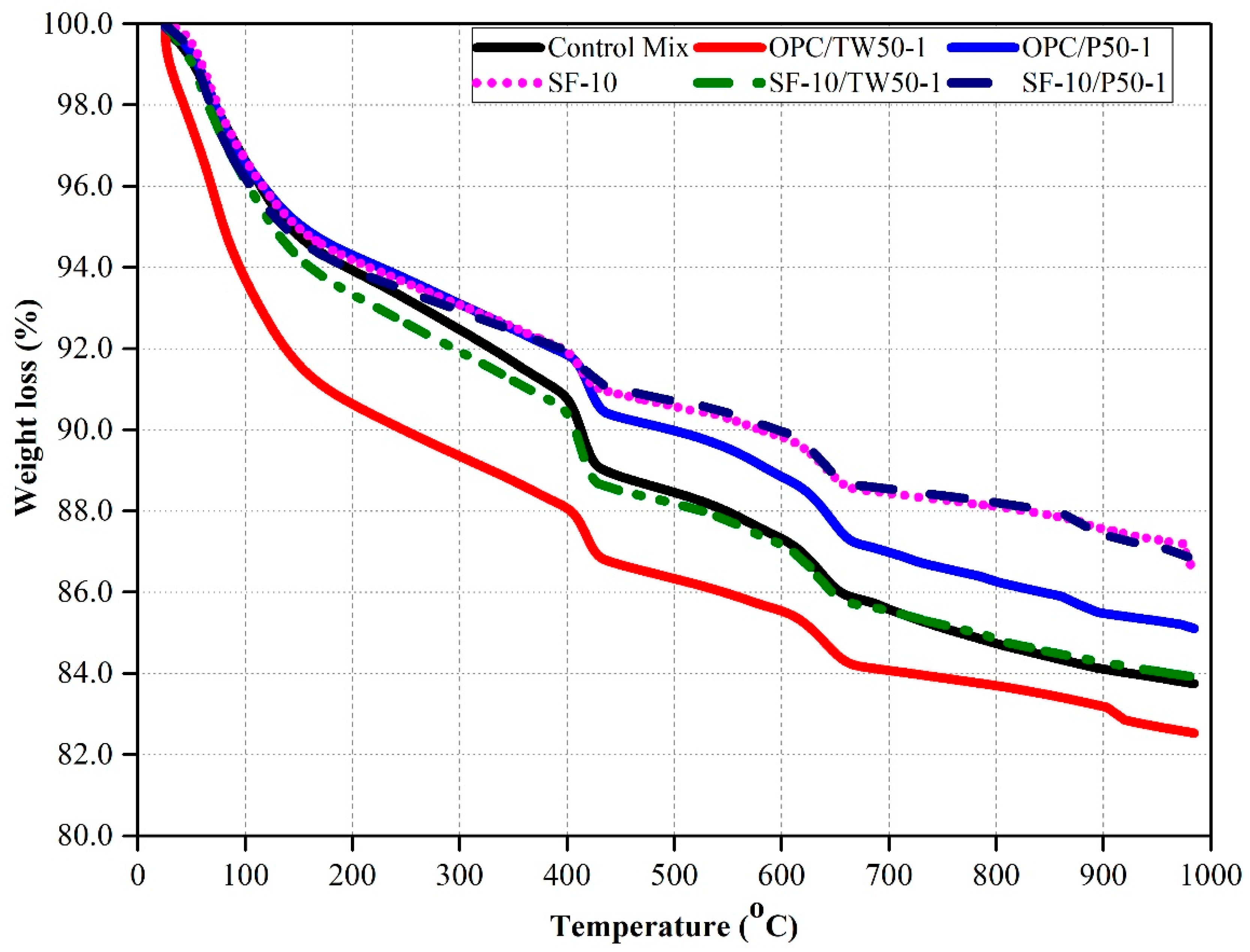
| Description | Results | |
|---|---|---|
| Chemical Composition of Binders (wt. %) | Ordinary Portland Cement (OPC) | Silica Fume (SF) |
| CaO | 62.00 | 1.50 |
| SiO2 | 20.80 | 88.70 |
| Al2O3 | 6.30 | 1.80 |
| Fe2O3 | 3.20 | 1.80 |
| MgO | 3.30 | 0.80 |
| SO3 | 2.20 | 0.10 |
| Na2O | 0.60 | 0.33 |
| LOI | 1.30 | 1.10 |
| Physical Properties | ||
| Specific gravity (g/cm3) | 3.15 | 2.20 |
| Blaine fineness (m2/kg) | 325.00 | 20,000.00 |
| Description | Results | |||
|---|---|---|---|---|
| Physical Properties | TW30 | TW50 | P30 | P50 |
| Specific gravity (g/cm3) | 0.342 | 0.465 | 0.345 | 0.650 |
| BJH adsorption cumulative surface area (cm2/g) | 1.307 | 1.773 | 0.832 | 1.107 |
| BJH adsorption cumulative pore volume (cm3/g) | 0.000819 | 0.001055 | 0.00694 | 0.00376 |
| BJH adsorption pore diameter (Å) | 25.066 | 23.809 | 33.70 | 13.582 |
| Absorption (%) | 215.00 | 110.00 | 75.00 | 47.00 |
| Moisture content (%) | 3.50 | 2.10 | 2.10 | 1.50 |
| Description | Results |
|---|---|
| Elemental Composition | Tea Waste |
| Carbon (C) (mass %) | 49.34 |
| Oxygen (O) (mass %) | 39.60 |
| Nitrogen (N) (mass %) | 07.89 |
| Calcium (Ca) (Mass %) | 01.31 |
| Phosphorous (P) (ppm) | 3802.00 |
| Sulphur (S) (ppm) | 3443.00 |
| Potassium (K) (ppm) | 2829.00 |
| Silicon (Si) ppm | 2020.00 |
| Iron (Fe) (ppm) | 1564.00 |
| Aluminum (Al) (ppm) | 1405.00 |
| Mix ID | OPC by Weight | SF Ratio by Weight of Cement | Binder/Sand (B/S) Ratio | TW30 % by Volume of Cement | TW50 % by Volume of Cement | P30 % by Volume of Cement | P50 % by Volume of Cement |
|---|---|---|---|---|---|---|---|
| Control mix | 1.0 | − | 1.25 | − | − | − | − |
| OPC/TW30-1 | 1.0 | − | 1.0 | − | − | − | |
| OPC/TW30-3 | 1.0 | − | 3.0 | − | − | − | |
| OPC/TW50-1 | 1.0 | − | − | 1.0 | − | − | |
| OPC/TW50-3 | 1.0 | − | − | 3.0 | − | − | |
| OPC/P30-1 | 1.0 | − | − | − | 1.0 | − | |
| OPC/P30-3 | 1.0 | − | − | − | 3.0 | − | |
| OPC/P50-1 | 1.0 | − | − | − | − | 1.0 | |
| OPC/P50-3 | 1.0 | − | − | − | − | 3.0 | |
| SF-10 | 0.9 | 0.1 | − | − | − | − | |
| SF-10/TW30-1 | 0.9 | 0.1 | 1.0 | − | − | − | |
| SF-10/ TW30-3 | 0.9 | 0.1 | 3.0 | − | − | − | |
| SF-10/ TW50-1 | 0.9 | 0.1 | − | 1.0 | − | − | |
| SF-10/ TW50-3 | 0.9 | 0.1 | − | 3.0 | − | − | |
| SF-10/P30-1 | 0.9 | 0.1 | − | − | 1.0 | − | |
| SF-10/ P30-3 | 0.9 | 0.1 | − | − | 3.0 | − | |
| SF-10/ P50-1 | 0.9 | 0.1 | − | − | − | 1.0 | |
| SF-10/ P50-3 | 0.9 | 0.1 | − | − | − | 3.0 |
© 2019 by the authors. Licensee MDPI, Basel, Switzerland. This article is an open access article distributed under the terms and conditions of the Creative Commons Attribution (CC BY) license (http://creativecommons.org/licenses/by/4.0/).
Share and Cite
Jakhrani, S.H.; Ryou, J.S.; Atta-ur-Rehman; Jeon, I.K.; Woo, B.H.; Kim, H.G. Prevention of Autogenous Shrinkage in High-Strength Mortars with Saturated Tea Waste Particles. Materials 2019, 12, 2654. https://doi.org/10.3390/ma12172654
Jakhrani SH, Ryou JS, Atta-ur-Rehman, Jeon IK, Woo BH, Kim HG. Prevention of Autogenous Shrinkage in High-Strength Mortars with Saturated Tea Waste Particles. Materials. 2019; 12(17):2654. https://doi.org/10.3390/ma12172654
Chicago/Turabian StyleJakhrani, Sadam Hussain, Jae Suk Ryou, Atta-ur-Rehman, In Kyu Jeon, Byeong Hun Woo, and Hong Gi Kim. 2019. "Prevention of Autogenous Shrinkage in High-Strength Mortars with Saturated Tea Waste Particles" Materials 12, no. 17: 2654. https://doi.org/10.3390/ma12172654






